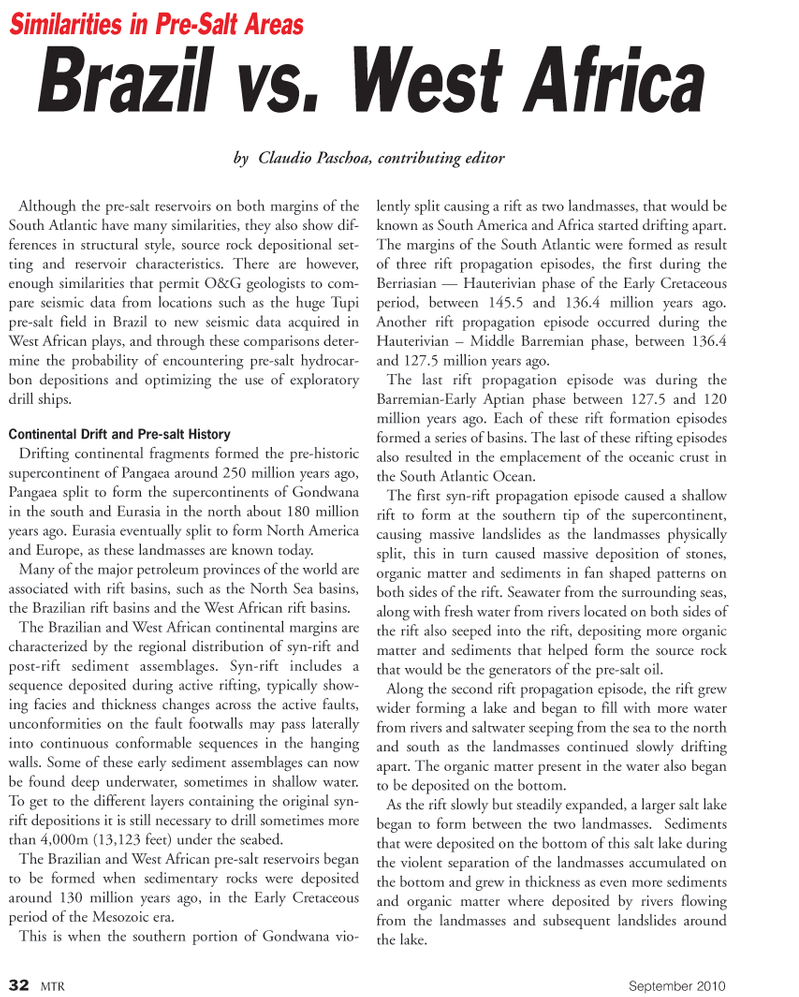
Page 32: of Marine Technology Magazine (September 2010)
Ocean Observation
Read this page in Pdf, Flash or Html5 edition of September 2010 Marine Technology Magazine
Although the pre-salt reservoirs on both margins of the
South Atlantic have many similarities, they also show dif- ferences in structural style, source rock depositional set- ting and reservoir characteristics. There are however, enough similarities that permit O&G geologists to com- pare seismic data from locations such as the huge Tupi pre-salt field in Brazil to new seismic data acquired in
West African plays, and through these comparisons deter- mine the probability of encountering pre-salt hydrocar- bon depositions and optimizing the use of exploratory drill ships.
Continental Drift and Pre-salt History
Drifting continental fragments formed the pre-historic supercontinent of Pangaea around 250 million years ago,
Pangaea split to form the supercontinents of Gondwana in the south and Eurasia in the north about 180 million years ago. Eurasia eventually split to form North America and Europe, as these landmasses are known today.
Many of the major petroleum provinces of the world are associated with rift basins, such as the North Sea basins, the Brazilian rift basins and the West African rift basins.
The Brazilian and West African continental margins are characterized by the regional distribution of syn-rift and post-rift sediment assemblages. Syn-rift includes a sequence deposited during active rifting, typically show- ing facies and thickness changes across the active faults, unconformities on the fault footwalls may pass laterally into continuous conformable sequences in the hanging walls. Some of these early sediment assemblages can now be found deep underwater, sometimes in shallow water.
To get to the different layers containing the original syn- rift depositions it is still necessary to drill sometimes more than 4,000m (13,123 feet) under the seabed.
The Brazilian and West African pre-salt reservoirs began to be formed when sedimentary rocks were deposited around 130 million years ago, in the Early Cretaceous period of the Mesozoic era.
This is when the southern portion of Gondwana vio- lently split causing a rift as two landmasses, that would be known as South America and Africa started drifting apart.
The margins of the South Atlantic were formed as result of three rift propagation episodes, the first during the
Berriasian — Hauterivian phase of the Early Cretaceous period, between 145.5 and 136.4 million years ago.
Another rift propagation episode occurred during the
Hauterivian – Middle Barremian phase, between 136.4 and 127.5 million years ago.
The last rift propagation episode was during the
Barremian-Early Aptian phase between 127.5 and 120 million years ago. Each of these rift formation episodes formed a series of basins. The last of these rifting episodes also resulted in the emplacement of the oceanic crust in the South Atlantic Ocean.
The first syn-rift propagation episode caused a shallow rift to form at the southern tip of the supercontinent, causing massive landslides as the landmasses physically split, this in turn caused massive deposition of stones, organic matter and sediments in fan shaped patterns on both sides of the rift. Seawater from the surrounding seas, along with fresh water from rivers located on both sides of the rift also seeped into the rift, depositing more organic matter and sediments that helped form the source rock that would be the generators of the pre-salt oil.
Along the second rift propagation episode, the rift grew wider forming a lake and began to fill with more water from rivers and saltwater seeping from the sea to the north and south as the landmasses continued slowly drifting apart. The organic matter present in the water also began to be deposited on the bottom.
As the rift slowly but steadily expanded, a larger salt lake began to form between the two landmasses. Sediments that were deposited on the bottom of this salt lake during the violent separation of the landmasses accumulated on the bottom and grew in thickness as even more sediments and organic matter where deposited by rivers flowing from the landmasses and subsequent landslides around the lake. 32 MTR September 2010
Similarities in Pre-Salt Areas
Brazil vs. West Africa by Claudio Paschoa, contributing editor

 31
31

 33
33
